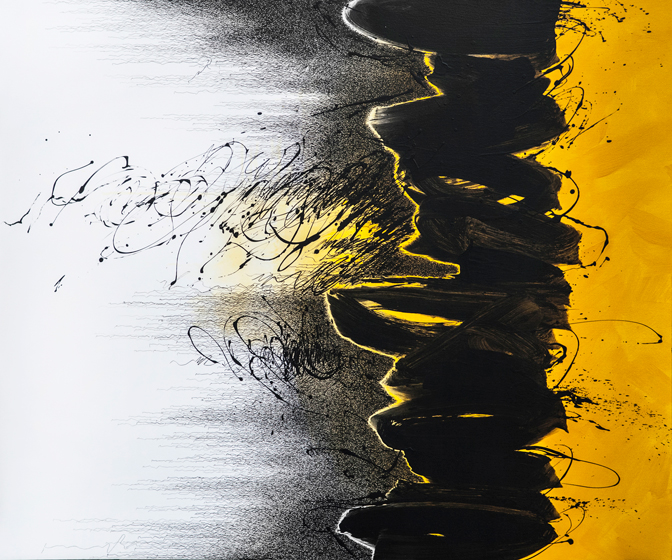Golnaz Fathi's work is trans-cultural both in concept and in execution as it incorporates her extensive training in traditional Arabic calligraphy with graphic design, painting, and autobiography. She first discovered calligraphy while studying graphic design at Tehran’s Azad University, which she later left to train for six intensive years at the Calligraphy Association of Iran. She is the first woman to win an award for Ketabat (a genre of calligraphy) – but she soon tired of the discipline’s rigid rules and regulations. Fathi has turned the calligraphic art form on its head by skillfully transforming known language into form and composition in her paintings and works on paper. She is self-taught in painting, rooted in contemporary Iranian culture but citing international artists such as Robert Motherwell, Helen Frankenthaler, and Cai Guo-Qiang as deeply important to her aesthetic development.
Every Breaking Wave (2), 2014 Acrylic & pen on canvas 55.4 x 66.3"
Since her mark-making originated with calligraphic study, there is a connection between verbal and visual language for Fathi. In her recent works, Fathi leaves expansive white space as a meditation on silence; she believes it gives the viewer room to pause or take a breath. Her use of color is also deliberate; she paints mostly with black because she believes it is the "complete" color, expressing everything essential to her. Red is a symbol of energy; blue, the color of mosques; and yellow, representing new life, is the most recent addition to her palette. While the text in her paintings are not specific lines of poetry, Fathi says she is influenced by the medieval Persian poet, Hafez. There is one verse in particular which she feels truly represents her personality which loosely translates into 'the world doesn't wait - life goes on'. This is particularly poignant coming from an artist who recently decided to permanently relocate from her native Tehran to Paris. Fathi's experiences are reflected in her paintings and the results are compelling and rich in graphic content and aesthetic intent.
The Metropolitan Museum just acquired a Fathi last year, the British Museum has one, and the Brooklyn Museum and the Victoria and Albert Museum are in the selection process. She was nominated last year for the Jameel Prize, the V&A’s prize for international contemporary artist inspired by Islamic tradition.
